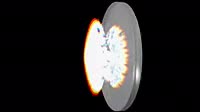Sunlight sky polarization. Animation showing how the polarization of sunlight as it impacts atoms in the atmosphere depends on the orientation of the light and the viewing angle. Polarization refers to the orientation of the oscillations of electromagnetic waves perpendicular to their direction of travel. Light from the sky (sunlight interacting with atoms in the atmosphere) is partially polarized, depending on the viewing direction: the scattered light coming from the part of the sky 90 degrees rotated to the position of the sun is polarized parallel to the horizon, while scattered light close to the sun's position or 180 degrees rotated, shows almost no polarization. This animation shows why this occurs. Light coming from the sun (random orientation) is represented here by two groups of photons: those with an electric field parallel (red) and perpendicular (green) to the Earth's surface. When reaching the atmosphere, each photon interacts with air molecules by scattering. As a consequence, the 'red' photons mainly cause scattering along the plane formed by the direction of the incident light and the direction perpendicular to the Earth surface, while the the 'green' photons mainly scatter parallel to the Earth surface. Thus, an observer looking towards or away from the Sun sees scattered light from either sources with comparable intensity resulting in non-polarized sky light. An observer watching the sky at a 90 degrees angle to the Sun's position mainly sees those photons (green) polarized parallel to the Earth's surface.
Details
WebID:
C01807660
Clip Type:
RM
Super High Res Size:
1920X1080
Duration:
00:00:18.000
Format:
QuickTime
Bit Rate:
25 fps
Available:
download
Comp:
200X112 (0.00 M)
Model Release:
NO
Property Release
No













 Loading
Loading